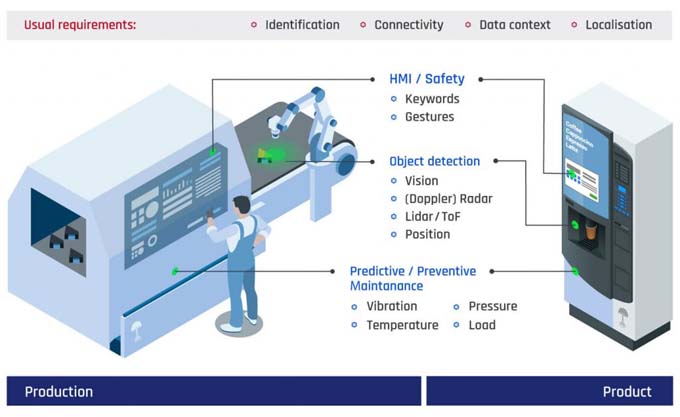Under the spell of the senses
Probably no sub-discipline of marketing affects us as directly, as subconsciously, as the play with our senses: the clever use of scents, sounds or visual stimuli reliably draws us under their spell. An essay.

Marcel Proust's novel "In Search of Lost Time" is an exploration of human memory - and the factors that set it in motion. Thus, the work also contains probably one of the most sensual (in the truest sense of the word) descriptions of what can happen to one while enjoying a simple sweet: The protagonist dips a sand tart, called a "madeleine" in France, into a sip of tea - and suddenly feels transported back to his own childhood: "All at once the memory was there," he notes. He continues, "The taste was that of that little piece of a madeleine that my aunt Léonie offered me after dipping it in her black or lime blossom tea."
Tastes and scents can penetrate the depths of our subconscious.
Yes, tastes and scents have a remarkable property: they can penetrate the depths of our subconscious and evoke memories we didn't even know existed. This property makes scents and flavors a powerful marketing tool. In fact, the involvement of all five senses is already part of the agenda in marketing; yet it is talked about rather little. So what is the secret of sensory marketing?
A powerful instrument
First of all, it is no secret that sensory marketing is extremely effective. More and more studies confirm that brand loyalty and purchase probability increase proportionally to the dimensionality of the touchpoint. In neuroeconomics, one even speaks of the "law of multisensory amplification": the more sensory channels are stimulated, the faster and more intensively an impression is processed. Numerous practical examples can be cited to illustrate this: A classic is the 1995 experiment by Alan R. Hirsch, "Effects of Ambient Odors on Slot-Machine Usage in a Las Vegas Casino." The study recorded an increase in revenue of about 45 percent for slot machines in an aromatized environment versus a neutral-smelling atmosphere. The examples can be continued at will: Think of the perfumes and carefully chosen color palettes in hotel interiors, or the smell of fresh-cut grass in sporting goods stores, customer letters with the scent of sunscreen, tasting morsels in supermarkets, or the feel of drinking bottles like Orangina ...
Multi- and intermodal game
According to the law of multisensory amplification, these marketing strategies owe their effectiveness to a multi- and intermodal interaction. Let's think of the scene from Proust's novel: it's not just the sight that brings the memory to life, but also the smell, taste and consistency of the pastry mixed with tea. The combination must be right to achieve the desired result. Artificially creating this coherence is the great challenge in multisensory marketing. If the interplay is not successful, confusion and sensory overload will result. It is therefore to be hoped that research in neurology and psychology will soon develop more precise models for the design of multidimensional sensory messages: knowledge which, in addition to marketing, could also become relevant in other contexts such as learning psychology, psychotherapy and psychoanalysis, or in the medical treatment of pain and sleep disorders, for example.
Why are potato chips bigger than your mouth? So that it really cracks when you bite!
It must be taken into account that a modal-specific stimulus can suggest or influence impressions of the other four sensory stimuli: Scents or sounds can trigger color impressions, and colors in turn can trigger smells and tastes. Therefore, for example, brand names, packaging sizes and materials, and eating sounds can influence the evaluation of a taste. Why else are potato chips bigger than your mouth? So that it really cracks when you bite!
Subtlety of the stimuli
Another recipe for success in multisensory marketing has to do with the subtlety of the stimuli and their direct access to the emotional world. Visual sensory impressions account for around 83 percent of perceptions, acoustic stimuli 11 percent. These two senses, which are most prominent anyway, are also in the foreground in traditional marketing. The utilization of the visual and acoustic communication market is therefore high. No wonder, then, if traditional advertising is no longer perceived properly or is even perceived as annoying.
The situation is quite different for the sense of smell: It comprises only 3.5 percent of conscious perception, haptics and the sense of taste only 1.5 percent and 1 percent, respectively. This does not mean that these senses work less precisely, but that their stimuli are largely taken in unconsciously. You may be familiar with the image of the iceberg floating on the sea, with most of it lying underwater: The magnitude of what is happening beneath the surface of consciousness is enormous. It is estimated that at least 70 percent of purchasing decisions are made unconsciously. The possibility of directing the unconscious through sensory marketing therefore promises uncanny potential.
A promising candidate
The sense of smell is the most promising candidate for sensory marketing. Scientists Richard Axel and Linda Buck, who were awarded the Nobel Prize for Medicine in 2004, have shown, among other things, that the human memory can remember around 10,000 smells, but only 200 colors. It is also known that the olfactory center has direct connections to memory and the limbic system. This is the brain region where unconscious feelings arise. Therefore, smells are closely linked to emotions and memories: The smell of madeleines dipped in lime blossom tea or the perfume of your first great love - just a whiff of it can vividly recall past experiences, people and feelings in all their details. Thus, the sense of smell forms the perfect instrument for brand recognition.
Smells are not only excellent carriers of memories and emotions. They are also particularly effective for marketing because, depending on their intensity, their persuasive effect goes unnoticed. In fact, unlike other sensory perceptions such as sight and hearing, the impulses of the sense of smell do not usually pass through the thalamus, the gateway to consciousness. Perhaps this is one reason why they are so little talked about: Fragrances can influence our emotional state without us noticing.
Ethical issues
Because sensory marketing often goes unnoticed, it also raises ethical questions. Olfactory marketing in particular is suspected of interfering with free decision-making. After all, what takes place below the threshold of consciousness cannot be critically evaluated. Should fragrances be designed in such a way that they are actively perceived as advertising? Here the problem arises that the effectiveness would probably decrease if the sensory measure were evaluated as such. Once a person realizes that they are being manipulated in making their decisions, they are more likely to think unfavorably about the source of the steering. But are pleasant scents, crisp chips, friendly staff, and coherent interior design experienced as manipulation at all?
Because sensory marketing often goes unnoticed, it also raises ethical issues.
The secret of sensory marketing lies in the influence of the intermodal interaction of different sensory stimuli on the unconscious. Its great potential makes it an influential but highly complex advertising tool, which will establish itself with further research steps in the field of multisensory marketing. But growing knowledge in this field brings responsibilities. After all, the unconscious is also the home of a personality, storage place of childhood memories and censoring instance of the deepest desires and most abysmal thoughts. Sometimes these materialize in smells and tastes, and when we inhale, they blossom. Even if we were to lose all memory, even "after the death of men and the ruin of things," we learn from Marcel Proust, "then, as the only ones, more delicate but more permanent, more insubstantial, more constant and more faithful, the smell and the taste persist, to remember for a long time, like souls, to wait, to hope, to carry above the debris of all that remains, on their almost intangible droplet, without yielding, the immense edifice of memory."
EXAMPLES
These brands use sensory marketing
Visa
When paying with their Visa card, customers in the USA hear a special sound at the end - one that Visa has been working on for years. It completes the purchase and conveys security and familiarity.
Singapore Airlines
Singapore Airlines flight attendants not only wear uniforms in a color combination based on traditional patterns; they also wear a perfume (rose, lavender and citrus) that is highly recognizable to travelers.
Apple
The design of the Apple boutiques is a masterstroke, both visually and haptically - the stores should be perceived as "clean" and "smart" as the company's products.
Starbucks
From the very beginning, the American café chain has required its branches to grind coffee beans on site - so that it smells like fresh coffee at all times and visitors are encouraged to consume it.
Would you like to learn more about sensory marketing? Then we recommend "Customer Sense" by the American professor Aradhna Krishna: a standard work that is appreciated by academics as well as in practice and excellently describes the game with our five senses in marketing.










 Sophisticated campaign pages, large color images and contemporary design elements underscore the work of Caritas. Fast and intuitive donation options offer supporters the opportunity to support people in need and those affected by poverty even more easily. First figures and experiences since go-live are promising.
Sophisticated campaign pages, large color images and contemporary design elements underscore the work of Caritas. Fast and intuitive donation options offer supporters the opportunity to support people in need and those affected by poverty even more easily. First figures and experiences since go-live are promising. In line with the content of the event, which is organized annually by Admeira and Goldbach Media, the appearance and the logo were created in moving form in accordance with the medium and, building on this, were also implemented statically. The new logo symbolizes a portal into the world of television, showing, as it were, a glimpse into the programs of the future. It aims at the questions "What's up?", "What's next?". The brand typography draws on the history of television and brings these associations into the present day.
In line with the content of the event, which is organized annually by Admeira and Goldbach Media, the appearance and the logo were created in moving form in accordance with the medium and, building on this, were also implemented statically. The new logo symbolizes a portal into the world of television, showing, as it were, a glimpse into the programs of the future. It aims at the questions "What's up?", "What's next?". The brand typography draws on the history of television and brings these associations into the present day.

 Migros leads the Swiss Reputation Ranking again this year, after being pushed down to second place by Victorinox last year. Dr. Anja Reimer of GfK Switzerland explains Migros' success: "Migros is the company with which the Swiss population can identify most strongly, and which achieves top scores in terms of socio-moral reputation. Here, Migros is more than four percentage points ahead of the next best company."
Migros leads the Swiss Reputation Ranking again this year, after being pushed down to second place by Victorinox last year. Dr. Anja Reimer of GfK Switzerland explains Migros' success: "Migros is the company with which the Swiss population can identify most strongly, and which achieves top scores in terms of socio-moral reputation. Here, Migros is more than four percentage points ahead of the next best company."
 Inflation and the rapid rise in prices for food and many other products are the most important factor currently determining the shopping behavior of the Swiss. This is the result of the Shopping Trend Study 2023 by Bring! and Profital. The study was based on a survey of over 1,500 users of both apps. According to the survey, rising prices are also the issue that concerns consumers most when shopping (70 percent). They are followed at a great distance by product origin (44 percent) and sustainability (33 percent). Four out of five respondents (80 percent) said they currently pay attention to product prices when shopping. In August of last year, the figure was still 47 percent.
Inflation and the rapid rise in prices for food and many other products are the most important factor currently determining the shopping behavior of the Swiss. This is the result of the Shopping Trend Study 2023 by Bring! and Profital. The study was based on a survey of over 1,500 users of both apps. According to the survey, rising prices are also the issue that concerns consumers most when shopping (70 percent). They are followed at a great distance by product origin (44 percent) and sustainability (33 percent). Four out of five respondents (80 percent) said they currently pay attention to product prices when shopping. In August of last year, the figure was still 47 percent.



 It is well known that strong brands are more successful and guarantee a higher ROI. On average, the top 50 strongest brands in the BAV ranking perform more than one and a half times better than the average of all brands in stock indices such as Dow Jones or S&P. The BAV shows that strong brands have a pronounced brand stature on the one hand and high brand vitality on the other. The combination of esteem and trust on the one hand and relevance and differentiation on the other makes brands true powerbrands. Starting in 2022, Wunderman Thompson will conduct the world's largest brand survey in Switzerland on an annual basis, and this year there are some surprises in the ranking.
It is well known that strong brands are more successful and guarantee a higher ROI. On average, the top 50 strongest brands in the BAV ranking perform more than one and a half times better than the average of all brands in stock indices such as Dow Jones or S&P. The BAV shows that strong brands have a pronounced brand stature on the one hand and high brand vitality on the other. The combination of esteem and trust on the one hand and relevance and differentiation on the other makes brands true powerbrands. Starting in 2022, Wunderman Thompson will conduct the world's largest brand survey in Switzerland on an annual basis, and this year there are some surprises in the ranking.






